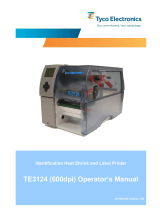
3
Table of Contents
1 Introduction ....................................................................................5
1.1 Product Description .........................................................................5
1.2 Instructions ......................................................................................5
1.3 Intended Use ...................................................................................6
1.4 Disclaimer ........................................................................................6
1.5 Safety Instructions ...........................................................................6
1.6 Environment .....................................................................................7
2 Installation ......................................................................................8
2.1 Printer Overview ..............................................................................8
2.2 Unpacking and Setting-up the Printer ..............................................9
2.3 Connecting the Printer ...................................................................10
2.3.1 Connecting to the Power Supply ................................................10
2.3.2 Connecting to a Computer or Computer Network ......................10
2.4 Switching on the Printer ................................................................. 11
3 Control Panel ...............................................................................12
3.1 Structure of the Touchscreen Display ............................................12
3.2 Operating the Touchscreen Display ...............................................12
3.3 Symbols on the Start Display .........................................................13
3.4 Printer States .................................................................................14
4 Loading Media ..............................................................................15
4.1 Loading Media from Roll ................................................................15
4.2 Loading Externally Fed and Fanfold Media ...................................16
4.3 Adjusting the Media Sensor ...........................................................17
4.4 Loading Transfer Ribbon ...............................................................18
4.5 Setting the Feed Path of the Transfer Ribbon ...............................19
5 Cutter / Perforator (Option) .........................................................20
6 Printing Operation .......................................................................21
6.1 Printing in Tear-off Mode (For Labels only) ....................................21
6.2 Printing in Cutting Mode ................................................................21
6.3 Synchronizing the Media Feed ......................................................21
7 Maintenance .................................................................................22
7.1 Cleaning Instructions .....................................................................22
7.2 Cleaning the Printhead ..................................................................22
7.3 Changing the Printhead .................................................................23
7.4 Cleaning or Replacing the Print Roller ...........................................24
7.5 Cleaning Cutter / Perforator and Replace Blades ..........................25
8 Fault Correction ...........................................................................27
8.1 Types of Errors ..............................................................................27
8.2 Problem Solution ...........................................................................27
8.3 Error Messages and Fault Correction ............................................29






















